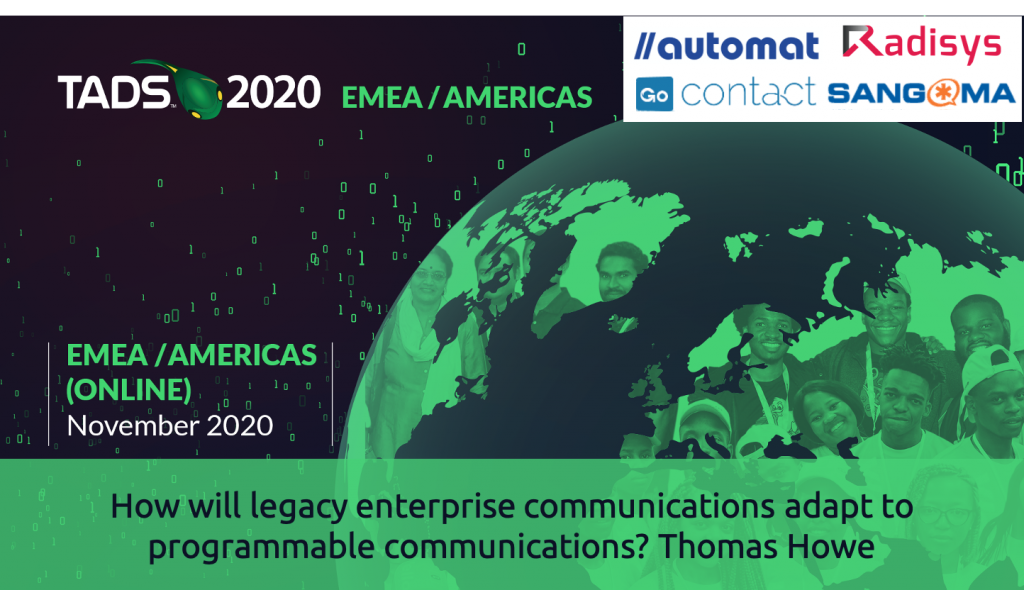How will legacy enterprise communications adapt to programmable communications? Thomas Howe, Chief Technology Officer at VHT
This is an excellent strategic thought-leadership work. Thomas sets out the assumptions that have driven legacy enterprise communications:
- From 100 years ago, we prefer to talk. Just look at how people use their smartphones today, voice is far down the list of things to do.
- From 50 years ago, voice is voice. Or rather voice is calling. Voice is done in context, and is often an ingredient of communications.
- From 10 years ago mobile apps will dominate enterprise:customer communications. Apart from a few exceptions, most brands’ apps are not adopted by most of their customers.
Thomas captures the state of the art in contact centers well, with some choice phrases.
- CCaaS is doing exactly what it says, putting the legacy contact center in the cloud to save costs.
- Enterprises are avoiding voice investments as its expensive compared to messaging investments, agents can serve more concurrent messaging customers.
- Automation is the snake oil of 2020 (I really like this phrase). Voice is here to stay, as even offshoring delivered an inferior customer experience product, so how will a computer do better?
Thomas and I are aligned on the ‘scorpion DNA’ of social media for customer communications. Social media should not be at the core of a brand’s customer data / communications strategy. Did I mention you should not be using Facebook 😉
Infrastructure: recognize the smartphone. 90% of VHT’s callbacks are to smartphones, which have voice, text, video, camera, browser, etc. that can use used for most communications. It’s important to acknowledge the reality that most customers do not have your app, yet have universally accessible communications tools that are NOT social media. Some customers will use your app, yet most customer will not.
Thomas wraps up on where CPaaS needs to evolve, beyond the atomic communication actions and into conversations and sessions, which is where the data is collected. Joined up thinking across an enterprise’s business processes, workflows, customers, and support. This is an important sign-post on the evolution of CPaaS.
Slideshare is having difficulties today, here’s a direct link to Thomas’s slides.
Agenda Description
Communications / telecoms is now programmable, almost anyone with web skills can do what was once protected in the ivory tower of telecom vendors. At global scale; and at telco grade availability.
We’ve witnessed the disruption in telecoms, legacy vendors and telcos ‘gathered the wagons’ to create a fortress against disruption.
The fortress isolated telcos from the market, so telecommunications is now seen as commoditized, no longer strategic. Their focus on faster internet access, and various cloud computing and IoT technology visions based on niche technology differentiation.
Many enterprise communication vendors grew out of the traditional telecom vendors. Offering a scaled down version of telco switches. They too are facing the disruption telcos and their vendors faced. However, the market conditions are different, standards are not a defense, and enterprises are generally not as complicit as telcos.
Thomas will share his perspectives on the evolution of enterprise communications, the coming disruptions and consolidation, and the opportunities being created as programmable communications disrupts the disruptors.


Thank you, Thomas, for your excellent strategic thought-leadership.
I agree, CPaaS need to evolve beyond the atomic communication actions and into conversations and sessions, which is where the data is collected. Twilio’s acquisition of Segment is a step in this direction.
Joined up thinking is required across an enterprise’s business processes, workflows, customers, and employees. Internal and external conversations are equally important. As an evolving CPaaS, where is a boundary in handing over the data / insights to the business process optimization folks?
I think the “Joined up thinking” comes when we start to migrate our contact centers from synchronous voice to asynchronous messaging. One of the problems with these automated workflows is “Who grabs the customer when the workflow goes south.” I know there are a few Enterprises that are afraid to enable the messaging on their corporate SMS numbers because they have no one in the contact center to text back. It’s a big change for them. Once that facility is available, it could unleash the flood.